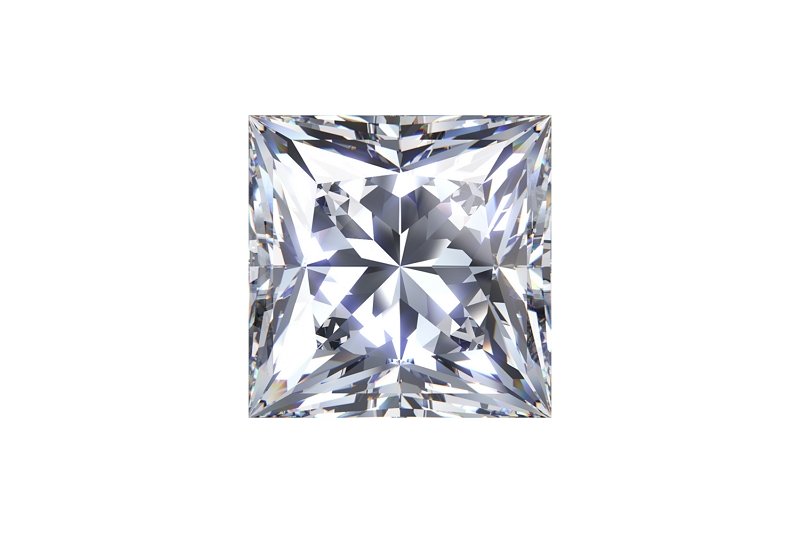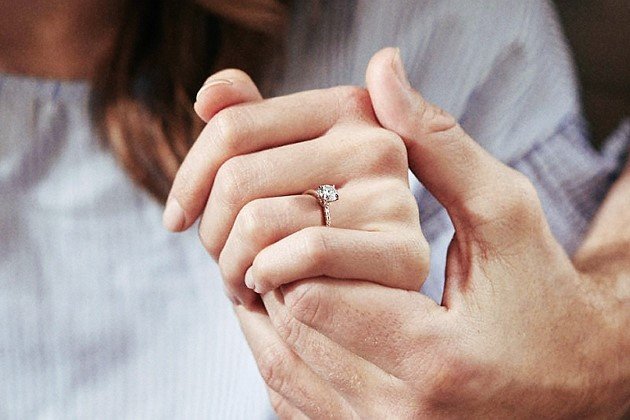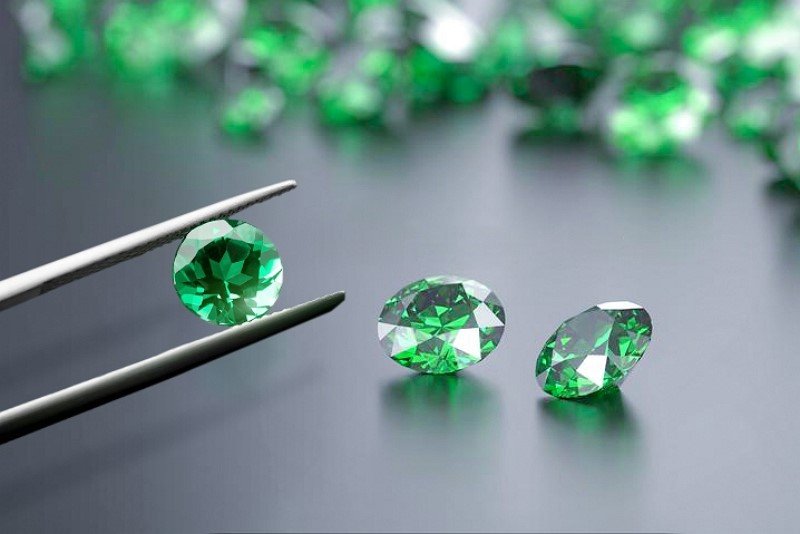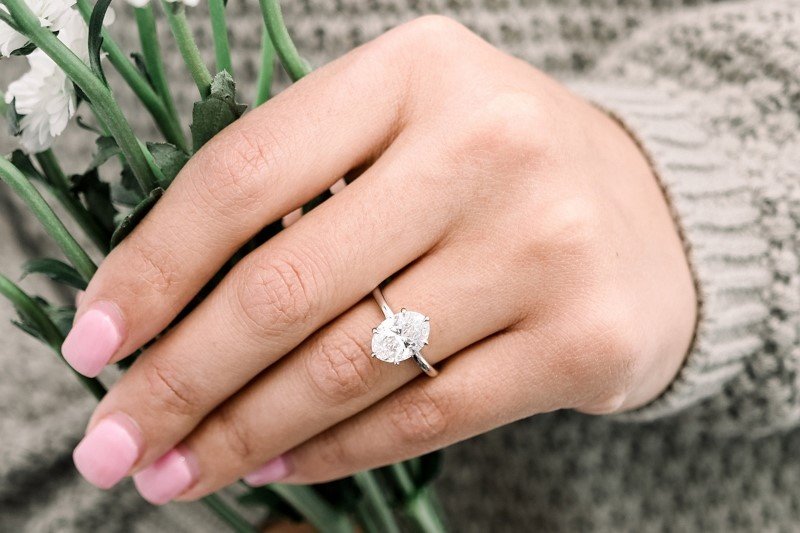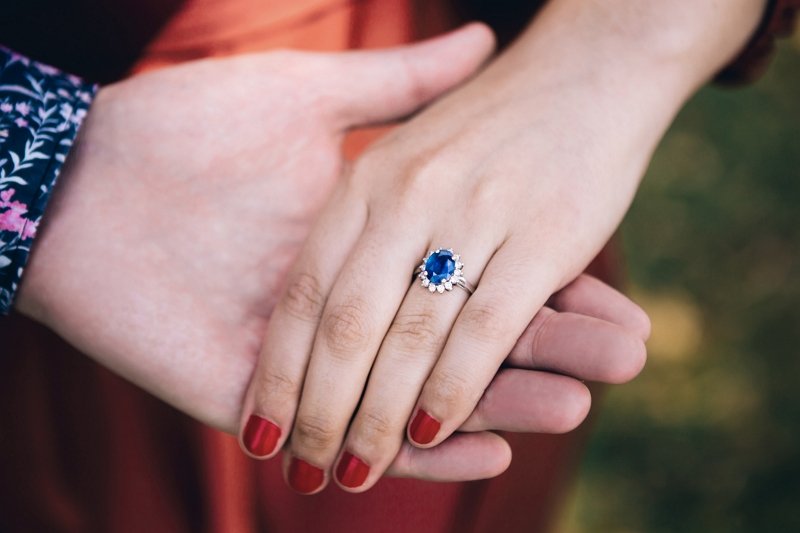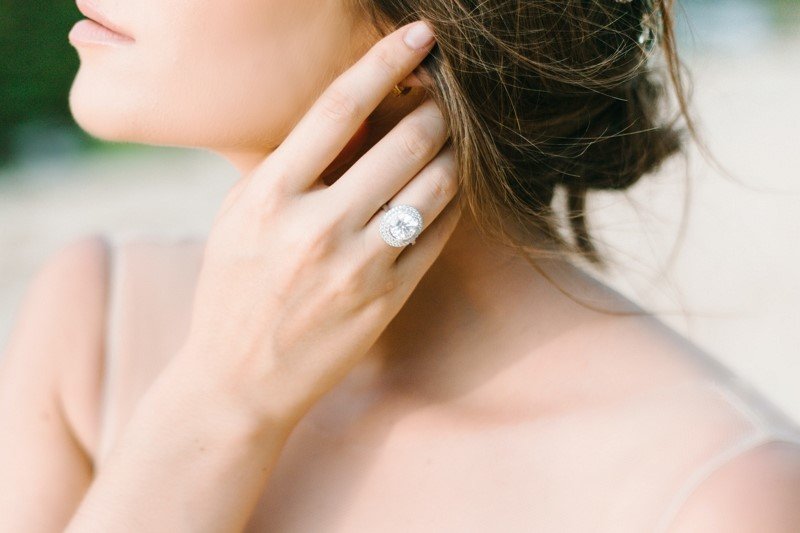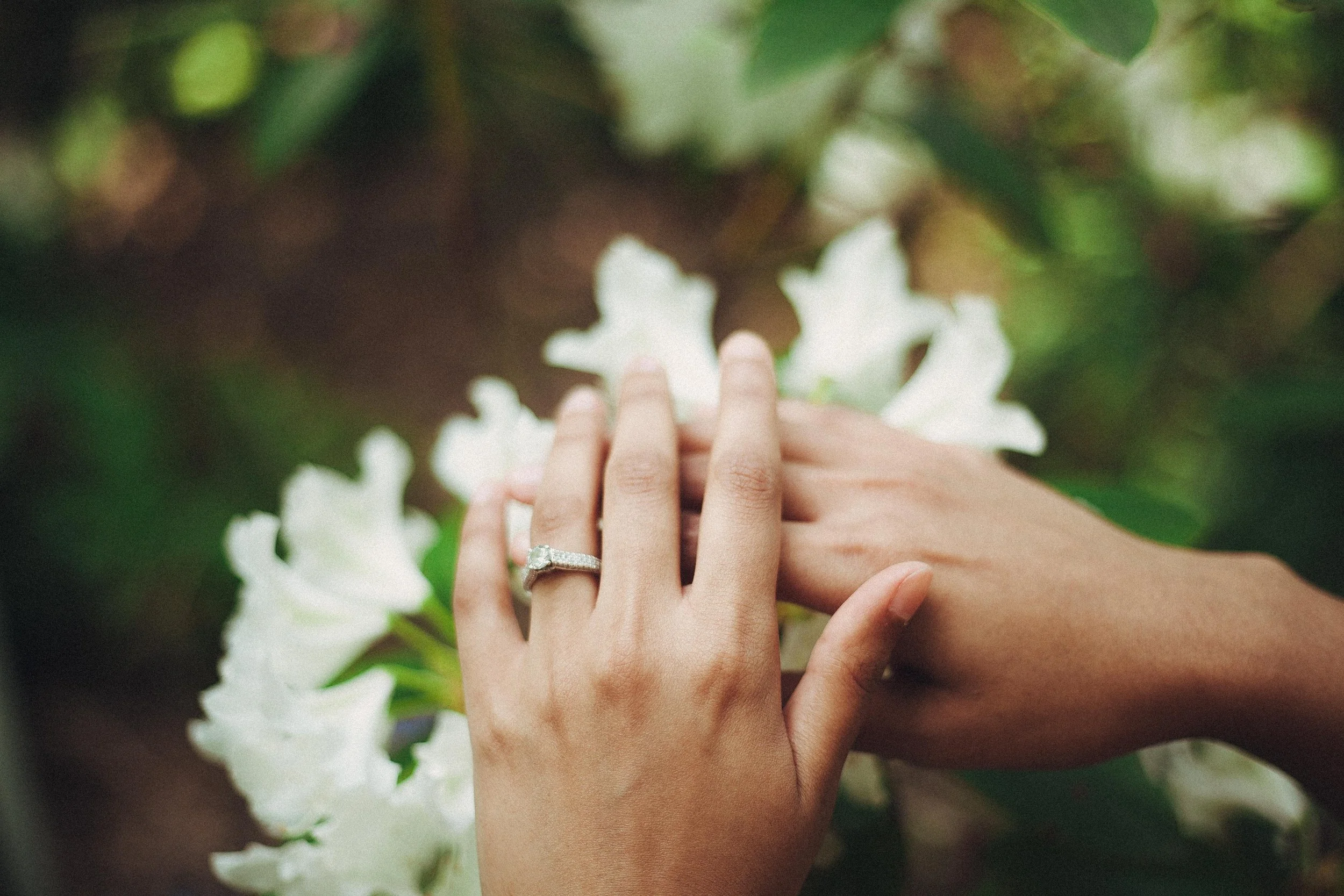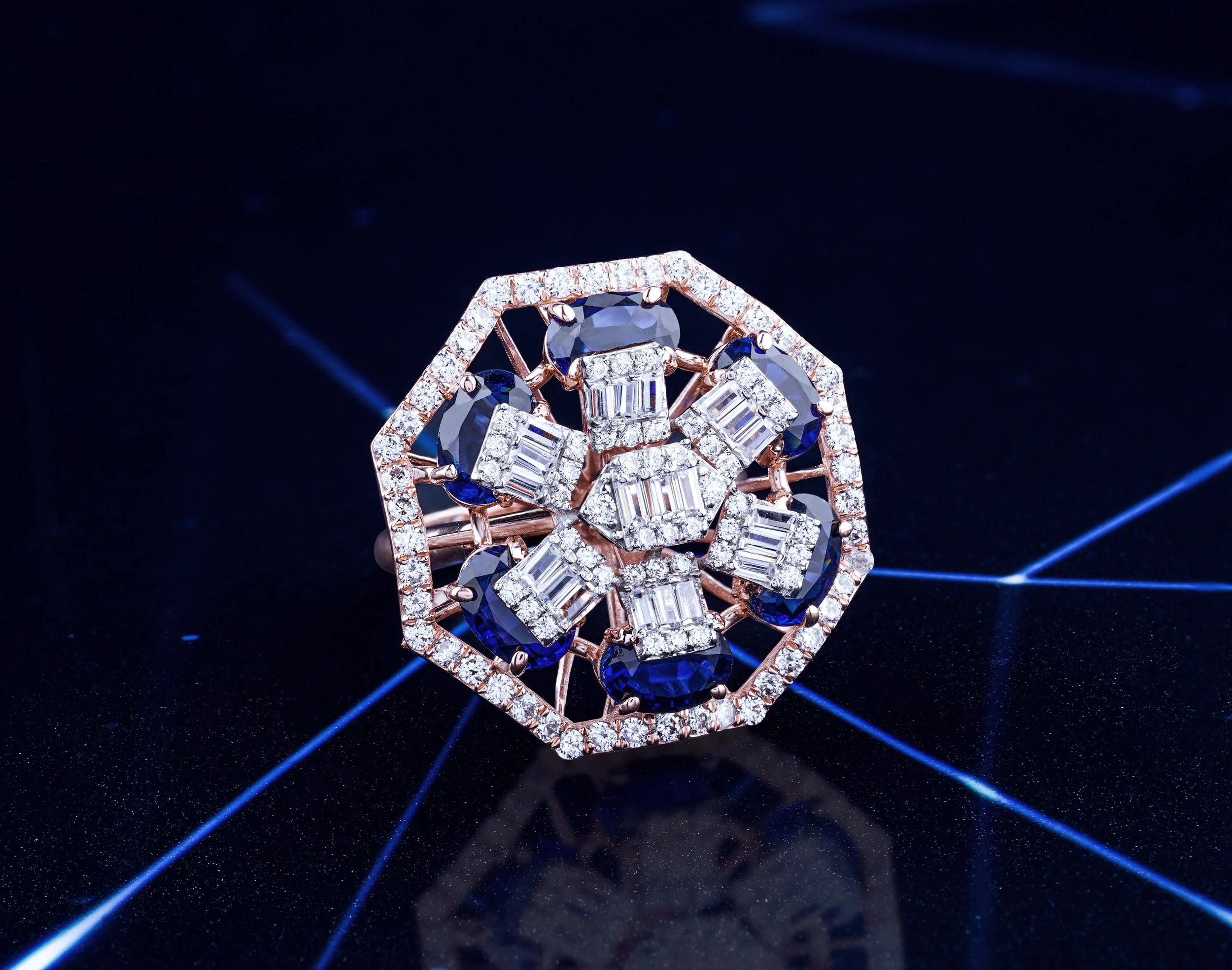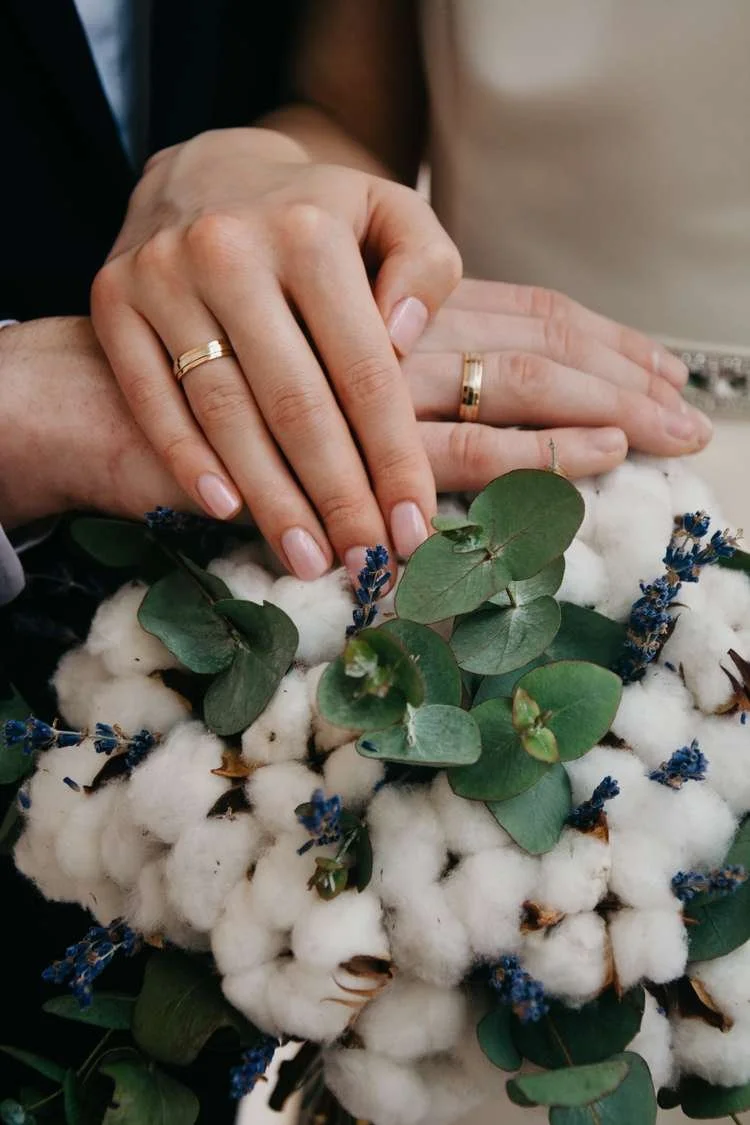6 Ways to Make Your Customized Engagement Ring Look Bigger
—
IN THIS ARTICLE
—
- 01 Choose the proper 4Cs for your customized engagement ring center stone
- 02 Choose the biggest possible diamond engagement ring for your budget: a lab-grown diamond is a wiser option
- 03 Choose a special setting for your customized engagement ring
- 04 Choose a special setting for your customized engagement ring
- 05 Add pavé to the diamond engagement ring setting
- 06 Choose a slim engagement ring band
- 07 Choose the right ring material
- 08 Other special services to customize engagement rings
When it comes to engagement rings, there is a wide and ever-expanding variety of styles and aesthetic choices. While some resonate more a minimalist engagement ring, others prefer a style that is intricate and show-stopping. Mass-produced engagement rings offer a basic selection that most of us have seen before, while a custom design can help your ring shine as bright as the love you and your partner share.
There are a few strategies that make can your ring stand out if you want it to appear larger and brighter than other, more standard rings. The 4Cs of a diamond (color, cut, clarity and carat), the setting of your ring, and the material are all customizable. It goes without saying: the appeal of a customized engagement ring is unmatched.
Choose the proper 4Cs for your customized engagement ring's center stone
A common misconception is that the sole factor affecting a diamond’s aesthetic is carat weight. While the carat weight alone determines how big a diamond appears, it is just one of the many factors that affect its appearance. Cut, color, and clarity also play a significant role in making a diamond appear larger. Carefully selecting the 4Cs of your diamond can play a role in making your engagement diamond look bigger.
Cut of the engagement ring
What’s a diamond’s “Cut”?
The quality of a diamond’s body and polish refers to its “cut.” This includes the stone’s depth, symmetry, and proportions. When describing the shape of a diamond, you may hear the term “cut,” as in “emerald-cut diamond,” “radiant-cut diamond,” or “princess-cut diamond.”
However, the term “diamond cut” has little to do with the diamond's shape. The cut quality influences the diamond’s brilliance and beauty. A diamond with an excellent cut is luminous, whereas a diamond that has been cut improperly will not shine. Differences in the cut may impact the beauty and value of a diamond.
Anything other than a round-cut diamond is considered a fancy-cut diamond. While round-cut diamonds are the best choice for the highest brilliance, certain fancy cuts can make the center diamond look bigger. The typical fancy shapes you'll see are:
Princess-cut diamond
The princess-cut diamond has a square shape. These diamonds will have more fire and brilliance than other cut diamonds. For example, a princess-cut diamond will appear larger than a round-cut diamond of the exact same carat size. This is because the princess shape has a larger table (the top of a diamond) than a round-cut stone, making it appear larger to the naked eye.
Emerald-cut diamond
Emerald-cut diamonds stand out with their large, open facets. This allows for more light absorption, and therefore, more reflection. The table of an emerald-cut will reflect the light it receives onto its interior, shaped like a set of steps.
Oval-cut diamond
The edges and form of an oval-cut diamond resemble a round diamond. Its blaze and sparkle are comparable, but its long face imparts a different look and style. This diamond will appear larger than other diamonds of the same carat.
Pear-shaped diamond
The Marquise and oval shapes are combined to create the pear-cut diamond. This gorgeous cut has one rounded end and one pointed end, creating a stunning pear shape.
Marquise-cut diamond
When seen from a horizontal position, the marquise cut resembles an exquisitely sculpted eye. Its slender and full shape aids in making the wearer's fingers appear longer and more attractive.
When the elongated surface of an oval-cut, pear-shaped, emerald-cut, or marquise-cut diamond occupies more area on your finger than a round brilliant-cut diamond, the diamond appears larger. They are about 10% larger than a comparable-carat round-cut diamond.
Color of the engagement ring
What’s a diamond’s “Color”?
The color grade of a colorless diamond describes how clear the diamond is. The diamonds with the top color grades are colorless, but lower-grade colorless diamonds frequently have a slight yellow tint. The right diamond can be selected by understanding the GIA color scale.
An increasingly popular choice is a diamond with fancy colors. Compared to a conventional colorless diamond, colored stones appear larger. Selecting light tones like pink, yellow, green, or blue, can trick the eye and make the stone appear larger. The color diversity of diamonds can highlight the center stone’s splendor and add a bespoke, one-of-a-kind touch to your engagement ring.
Clarity of the engagement ring
What’s a diamond’s “Clarity”?
A diamond's clarity grade, which ranges from “included” to “flawless”, indicates how many (and where) inclusions are present in the stone. An inclusion is a characteristic or flaw that develops either internally or externally during the formation of a diamond. Most inclusions, however, are too small to be seen by the naked eye.
Choose the proper clarity for your center stone
Flawless Diamonds (FL)
These are diamonds with no inclusions. They have a near-perfect appearance and are of the highest quality.
Very Slight Inclusions (VS)
VS clarity diamonds are still considered exceptional quality, but they are less expensive than the superior ones. These VS diamonds have some inclusions, which are not visible to the naked eye.
Slightly Included (SI)
These diamonds have inclusions which are not detectable the naked eye cannot detect, and do not take away from the diamond’s brilliance or beauty. Choosing diamonds in the SI3-I1 clarity range can give you a large-carat weight at a lower price. Without magnification, inclusions in these stones are typically invisible.
If you want your diamond to appear larger, choose one with a clarity grading between VVS1 (Very Very Slightly Included) and VVS2, VS1, or VS2 (Very Slightly Included). Unless you use a 10x magnifier with these clarity grades, it is essentially impossible to detect these flaws.
Choose the biggest possible diamond engagement ring for your budget: A lab-grown diamond is a wiser option.
Lab-grown diamonds are a better choice if you want a diamond with a large carat size without increasing your budget. At the same time, they’re eco-friendly, ethical, and sustainable.
What is a lab-grown diamond?
A diamond manufactured or developed in a laboratory is often known as a man-made or lab-created diamond. Notably, lab-created diamonds are just as real natural diamonds.
Lab-grown diamonds and natural diamonds are identical in terms of their physical, chemical, and visual characteristics.
Why choose a lab-grown diamond as the center stone?
Lab-grown diamonds cost much less than natural diamonds
The size of lab-grown diamonds may be a fascinating aspect for many potential customers. In contrast to natural diamonds, the price of lab-grown diamonds does not rise drastically as the size increases. Therefore, you may scale up the size while maintaining fair pricing.
A creative lab-grown diamond with a personal touch: A diamond from your hair
Numerous well-known online merchants offer lab-grown diamonds for sale. But Sunny Eden™ uses cutting-edge technology to create unique lab-grown diamonds from hair.
What is a diamond from hair?
Thanks to leader in the diamond from hair industry, and the first to bring this technology to the diamond engagement ring world, it is now possible turn hair into a diamond with unmatched luster and shine. Sunny Eden™ diamonds from hair can transform hair into a lab-grown diamond that is as genuine and pure as natural diamonds.
A diamond made from hair is a stunning crystallization of the carbon found in your hair.
This hair can be yours, your loved one’s, or both. Indeed, this makes the diamond even more valuable. These diamonds from hair have significant value for the wearer and can turn you and your loved one’s story into a timeless keepsake.
Choose a special setting for your customized engagement ring
The choice of ring setting also helps enhance the visual size of the diamond. The following are some of the recommendations for engagement ring settings.
Halo setting for the engagement ring
The halo setting is a ring of small accent stones, usually pavé diamonds, surrounding a larger center stone. Halo settings can have a form that matches the center stone or have a different shape, such as a cushion-cut halo encircling a round diamond.
Features of halo setting
A halo setting is designed to add size and brilliance affordably, making it look like one enormous sparkling diamond. The biggest appeal of a halo setting is that it accentuates the beauty of the center diamond and makes your diamond engagement ring appear larger by creating a magnifying effect.
Using a six-prong setting rather than a four-prong setting
Individual prongs in six-prong settings are generally lighter and thinner to minimize the area where prongs cover the diamond. A hexagonal shape is formed when six evenly spaced prongs are placed on a round diamond. Not only is diamond is held more firmly, but the six claws are also occasionally perceived as part of the diamond. Viewing this setting from a distance makes the diamond optically appear rounder and larger.
Add pavé to the diamond engagement ring setting
If you believe an engagement ring design is lacking, you should look for one with a pavé setting. This common technique gives an additional sparkle without taking away from your center stone, and an artistic touch that is both strong and tender.
Small diamonds are placed in rows around the engagement ring's band in a pavé setting. The diamonds are set close together like a diamond road.
What are the advantages of adding pavé to the setting of your diamond engagement ring?
The pavé setting gives the diamond engagement ring a more firey and show-stopping quality while enhancing the brightness of your center diamond. Together, the two offer a powerful sentimental punch. Additionally, the pavé setting brings your diamond engagement ring extra glitter and shine, making it dazzling and elegant-looking.
How do pavé settings make the engagement ring look bigger?
The band’s pavé setting gives the impression that the diamonds are running continuously. Due to the pavé setting's extra glitter, the diamond appears larger than it is.
A pavé setting is a popular choice for both large and small stones. Lower quality stones also look better in a pavé setting, because it hides any imperfections. The pavé setting is a well-liked option for people looking for the ideal ring due to its dazzle and affordability. Any diamond center stone set can be upgraded with a Pavé setting.
Common types of pavé settings for diamonds made from lab-grown diamonds
Micro pavé setting
Micro pavé settings give the illusion that the entire band is comprised of small diamonds. The diamond used to create this effect often weigh less than 0.1 carat.
For those who enjoy the glamorous shine of a diamond, rings of this type are an exquisite choice. The typical micro pavé setting can carry up to 50 diamonds and occasionally even more. A micro pavé setting may be more expensive than other types of engagement rings because of this, however.
U-cut pavé setting
When it comes to pavé, the U-cut is one of the most common settings. This type of setting has a more contemporary style. Smaller stones are put into several grooves in the u-cut diamond settings. As a result, when viewed from the side, it resembles a “U.”
A U-cut pavé setting combined with a sleek solitaire ring or beautiful filigree gives a vintage feel. This pavé style reduces metal while increasing diamond visibility and sparkle. It does this by allowing light to enter from the sides, without entirely hiding the natural beauty of your diamond engagement ring.
French pavé setting
French pavé is famous for its distinctive texture. In this design, the engagement ring’s band has V-shaped grooves into which pave-set diamonds are placed. While conceptually comparable to the U-cut, the French pavé increases a diamond’s shine by allowing more light to pass through. Since only a small amount of metal is needed to secure the accent diamonds in place, engagement rings in this setting are very trendy.
Petite pavé setting
The petite pavé, a traditional pavé setting, features tiny prongs to hold each micro pavé diamond in place. Each diamond appears larger and more prominent because of the tiny metal prongs.
Choose a slim engagement ring band
When aiming to make your diamonds look larger, always choose a slim, delicate diamond engagement setting that makes the center stone pop or appear as large as possible. A slim band will focus the eye on your diamond.
Advantages of a slim engagement ring band
Slim engagement rings are less expensive than those with broader bands. They often consume fewer materials, such as gemstones and metal.
Typically, diamond engagement rings with slim bands are more pleasant to wear than those with thicker bands. Overall size, weight, and placement on your finger play a role in this.
Slim band rings fit more easily on the finger, and they are much easier to resize if necessary.
Slim band engagement rings open more design choices. You can find twists, rope bands, and a plethora of other styles.
Slim band rings naturally highlight the center stone for a more opulent appearance. Regardless of the size of the stone, you can be sure that it will stand out against a thin band unlike any other.
Choose the right ring material
The material of the ring dramatically affects how the stone, and the ring as a whole, will look. Consider selecting platinum and 18k white gold when choosing ring settings. Despite a similar silvery tone, white gold and platinum are slightly different in terms of color, durability, and cost. Platinum is whiter, durable, and unquestionably more expensive than white gold.
18k white gold ring material
The central diamond of the ring will reflect the beautiful white brilliance of the 18k white gold band. As a result, it creates an impression of the engagement ring being larger. Furthermore, an 18k white gold ring is less expensive and more reflective than a platinum one.
White gold does not corrode, tarnish, or rust. It is also a lot more malleable than platinum, allowing for finer and more elaborate designs.
This substance is perfect for individuals who want the appearance of platinum without breaking their wallet. White gold’s pure white gloss is ideal for highlighting your diamond's glitter and magnificence.
Platinum ring material
Since platinum is a naturally white metal, it may create a cold tone without mixing it with other materials. Platinum is famous for its strength, durability, and attractive soft white tone. Additionally, it is 95% pure and hypoallergenic.
It should come as no surprise that platinum is the most expensive metal because it is also the densest and most long-lasting metal. Platinum is roughly 2.5 to 5 times more costly than white gold while having a 20% higher density.
Other special services to customize engagement rings
As well as selecting the right band, setting, and ring material to create your customized diamond engagement ring, there are additional aspects that are important to consider.
Personalization
Get a lab-grown diamond engagement ring that is uniquely yours by having it laser inscribed or engraved. Engrave a personalized message, date, or symbol into your Sunny Eden™ diamond ring to celebrate your relationship with your better half, or have your message laser inscribed directly onto the diamond itself. You and your partner's initials, an important date, or a meaningful and special message, are some ring engraving ideas from which you can draw inspiration.
Customization
Sunny Eden™ uses the carbon in your hair to create diamonds. They are an excellent choice for engagement rings since they offer personalization options and can share the individual love stories of each couple. This one-of-a-kind design idea captures your and your partner's individuality. Furthermore, these lab-grown diamond engagement rings are charming and profound.
Bring your own bespoke design
You can design your engagement ring from scratch at Sunny Eden™, and they may create a sketch of your ideas if you provide a photo, an idea, or any form of inspiration. Their skilled design team will also create a 3D model of the engagement ring to give you a clear and concise perception.
Bottom line
Everyone wants their diamond engagement ring to be unique, personalized, and sparkling. What's better than getting a customized lab-grown diamond engagement ring that appears to be larger by following some simple tactics?
Use the above-mentioned six ways to choose the best diamond engagement ring that appears large without being too heavy on your pockets. Indeed, opting for a lab-grown diamond engagement ring or a diamond from hair, and then customizing it, is the best option. You will get the diamond engagement ring of your choice with the same shine and aesthetic. And most importantly, it will be beyond meaningful.

